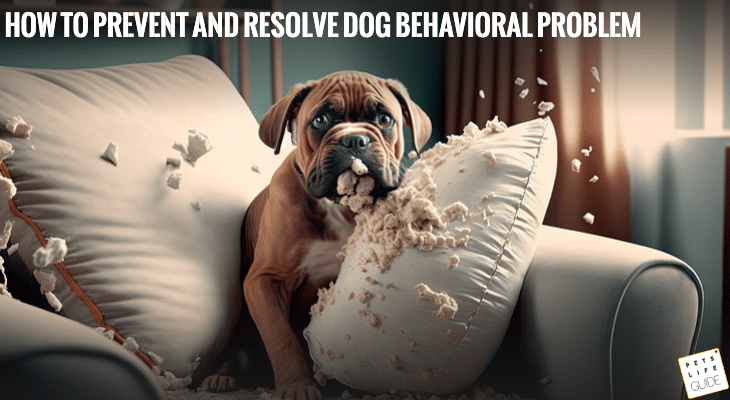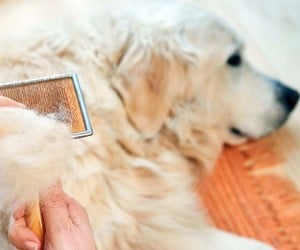Table of Contents
Ways to Prevent And Resolve Dog Behavioral Problem
Dogs are innately funny. However, some of their habits can irritate you, especially if they start to get out of control that you may think of giving them up. Learning about normal and abnormal dog behaviors will help you know how to fix their being unruly and have an enjoyable time with your furry friend.
Dog behavior is sometimes age-related. For instance, puppies are typically hyperactive, while older dogs may be less energetic and may not respond to commands. Other times, it could be because of the breed, an underlying disease, boredom, inadequate sleep, or nervousness due to environmental changes.
So, if you have a misbehaving dog, it’s best to assess the root cause of the problem to help you find the right solution. Training a dog to fix their rowdiness takes time. So, be patient with them and yourself, and you’ll ultimately have an admirable dog that acts the way you want them to. In light of this, below are 14 typical dog behavioral problems and how to prevent and resolve them.
-
Ignoring Commands Or Bad Mannerisms
It takes time for dogs to learn to respond to your commands, but they’ll eventually be able to do it with consistent training. You may start by reprimanding them when they’re doing something undesirable.
For example, if they jump on your bed, wet the floor, or run out of your compound when they shouldn’t, you can use words like ‘Stop! ‘No!’ ‘Drop it!’ or ‘Leave It!’ It’ll get your dog’s attention, and they’ll understand that their behavior is unacceptable. Making your voice loud and harsh helps reinforce the meaning of the command. And whenever the dog hears such, they’ll stop whatever they’re doing.
Consider professional dog training for quicker results. Experts know their way around canines—they can accurately diagnose their behavioral problems and propose feasible remedial measures. Training also helps build your furry friend’s confidence and stimulates them mentally.
-
Pleading For Food
Your dog can beg for food by giving you a craving look, especially when you have food in your hand or on the dining table. It can be tempting to give them the food because you feel it’s a one-time thing. However, the behavior can slowly develop, and it’ll feel normal for them. It can, in turn, embarrass you if you have guests at home. They might conclude that you don’t feed it well. For such reasons, you shouldn’t condone this habit.
Your dog could also overeat and may become obese or have digestion issues because of snacking all the time. In this case, it’d help to prevent the behavior completely by teaching your dog that begging isn’t allowed in your house.
You can put your dog in their crate or a secluded place when you eat. If they behave successfully, you can reward them with treats.
-
Improper Defecation And Urination
Dog urine and feces can significantly damage your floor woodblocks, tiles, or rugs. They may also make your home reek of foul odors. Your dog can mark places they’d like to use for elimination, which may not be what you want.
One solution is to monitor your dog constantly to check their favorite place to relieve themselves and put a potty there. They may not buy this idea immediately, but consistency will eventually yield the needed results. Another option is to dress them in dog diapers to prevent improper defecation and urination.
If your dog keeps pooping or peeing anywhere, even after training, consult your vet, as it might indicate a medical problem.
-
Chasing After People Or Animals
Dogs are generally playful and may find it pleasurable to chase after other animals in your yard, dogs, young kids, and vehicles. If your family members and guests aren’t used to the chasing, they can be terrified. Your dog can also get into an accident if they run after motorists or cars. Putting them on a leash is the best way to address this behavior. It’ll help you control your dog and prevent it from chasing anyone or anything if you’re outside.
On the other hand, you can teach your dog to listen to you by using a whistle. You can also use commands like ‘No’ to stop them in their tracks. In addition, taking them for regular walks may also make them get used to the outdoors, and the excitement that leads to chasing may reduce.
-
Digging Persistently
It’s normal for your dog to dig up occasionally. They may be hunting for hidden things, or they’re just bored. However, if the behavior is persistent and has already reached an uncontrollable level, they can significantly destroy your lawn or garden.
Thus, you’d want to designate a place or put up sandboxes where your dog can dig as much as they wish to without the risk of damaging precious items. You can tell your dog craves to dig if you notice them scratching the floor. Once it happens, take them immediately to their digging corner to relieve the urge.
Alternatively, you can play with your dog frequently to keep them occupied. It’ll help distract them from the digging.
-
Chewing On Items
Your dog can chew on anything they come across in your home. The behavior may stem from extra energy or nervousness. Teething puppies also tend to chew a lot. You can prevent this behavior by storing away all the possible things your dog may get their fancy. Alternatively, keep your dog in a separate area so they won’t chew on your items when you’re not in the house.
Moreover, you can look for toys and put them in your dog’s crate so they can chew on them. Also, let them know it’s not good for them to gnaw on your slippers or shoes. Whenever you catch them doing it, reprimand them and offer them their chewing toys.
In addition, you can take your dog outside to ensure they play enough to relax. And when they enter the house, they won’t be so eager to chew.
-
Jumpiness
Dogs tend to jump on people or furniture. Mostly, it’s to try and grab your attention or because they’re happy. While you shouldn’t condemn this behavior, you may have guests who may not take it kindly when your dog jumps on them, and they can quickly get irritated.
Firstly, you can prevent this behavior by avoiding eye or physical contact with your dog when you notice excitement building. Secondly, you can approach them quietly to prevent them from being thrilled and jumping on you. Lastly, command your dog to sit to prevent them from pouncing. Your furry friend will be able to gradually comprehend that jumpiness isn’t allowed at certain times.
Another option is to put a leash on them to stop them from jumping. Or you can train them by having a family member knock on the door. Put a leash on your dog before opening it. Then, meet the person knocking while telling your dog to sit. You can do this repeatedly, and if they still misbehave, restrict them using a leash. While at it, don’t scream at your dog or shove them away because it’ll make them feel unwanted.
-
Stealing Items Regularly
Your dog can often steal food or any other item in the house and hide it somewhere far. It can be challenging to prevent this behavior as they may not know it’s not allowed until you tell them so.
To solve this dilemma, you can close the pantry’s door or keep your dog away from the kitchen. Additionally, you can redirect your furry companion’s focus from what you’d want them to avoid. You can give them toys instead for them to chew on.
If you catch your dog stealing, you can ask them to drop or help remove what they have in their mouth. But if they’re hostile, you shouldn’t force it because they can bite you.
-
Separation Anxiety
Your dog can become so attached to you that they become anxious when you leave the house without them. They may start to misbehave and forget all the things you taught them. In this case, your dog may urinate anywhere, pace around the house or salivate uncontrollably, destroy things, and follow you to your car.
Fortunately, there are some steps you can take to address this issue. For instance, you can put your dog in their crate and then spend some time in the house until you feel your dog is comfortable. You can also leave toys for them in the crate to keep them occupied. But if your dog is still struggling, give them their anxiety medication or play soothing music.
-
Extreme Barking
Barking is one of the ways dogs communicate. They can do it because they want to warn you of certain dangers. It may also be a sign of anxiety, or they may simply be answering other dogs in the neighborhood. Most of these are understandable, but the barking can become annoying if it is excessive and done without reason. You can prevent such scenarios by responding quickly to their barks, checking outside, or letting them socialize with other dogs.
You can also teach your dog to keep quiet slowly and consistently, using commands like ‘Stop!’
-
Aggression Towards People Or Animals
Aggression is one of the scariest dog behaviors because they can bite you or anyone else when they start playing with them. It usually occurs when they guard their food or don’t like the presence of other dogs. One of the signs of an aggressive dog is if their teeth show while barking.
Aggression in dogs can be caused by fear, especially if you scare them suddenly or if they’re unwell, especially if your canine companion is older. Other culprits could be the following:
- Dental problems
- Ear pain
- Being hurt in their legs
You can prevent these problems by ensuring your dog socializes enough to learn to live with other dogs or people. You can also restrict them if you think the behavior could lead to damage. Alternatively, take your dog to the vet so they can check for underlying conditions. They’ll do tests to see if an injury or a medical issue is causing the aggression.
-
Biting People Or Other Dogs
Your dog may bite people or other animals for a number of reasons. They may be unwell or are trying to defend themselves. A solution for this is allowing your dog to socialize frequently so they’ll know how to behave in the presence of entities outside their home. The more comfortable they feel in certain situations, the less likely they’ll exhibit any form of aggressiveness.
-
Leash Pulling During Walks
It might be challenging to stop your dog from pulling the leash during walks because they mostly just want to run around. You can prevent this by keeping up with their pace, ensuring they don’t pull the leash too much. However, while they’re still learning the ropes of proper behavior in their walking sessions, you can get them a no-pull harness to stop your dog from hurting themselves when they try to run away from you.
-
Running Away From Home
Your dog could quickly run away from home because they naturally like to hunt. Certain dog breeds, like Labrador retrievers, cherish hunting and staying home always feels boring to them. Consider taking your dog for a walk frequently to decrease their desire to go out.
In some instances, they may not like the home setting. So, inspect your home to identify things your dog doesn’t like in the house and remove them. Also, consider fencing your yard, so your dog doesn’t wander from home.
Conclusion
The good news is that you can prevent most dog behavior problems by training them—it’s not a hopeless case. Dogs can easily learn commands when you teach them regularly. However, it’s a must to be realistic with your goals and remember that training might take time; it’s never an overnight affair. So, be patient with your furry companion, have the right equipment, and avoid reprimanding them excessively. In no time, you’ll have the most obedient and well-behaved dog, just like you’ve always envisioned.






Leave a Reply